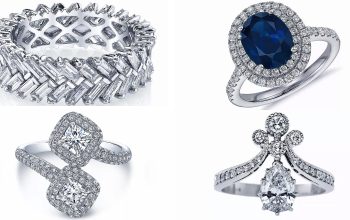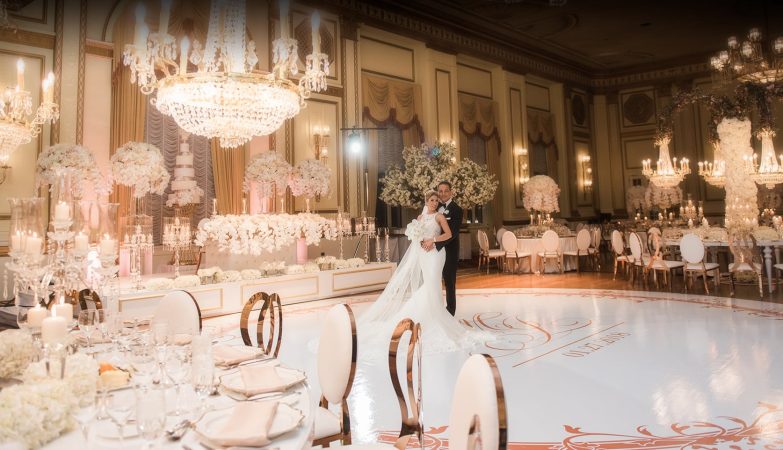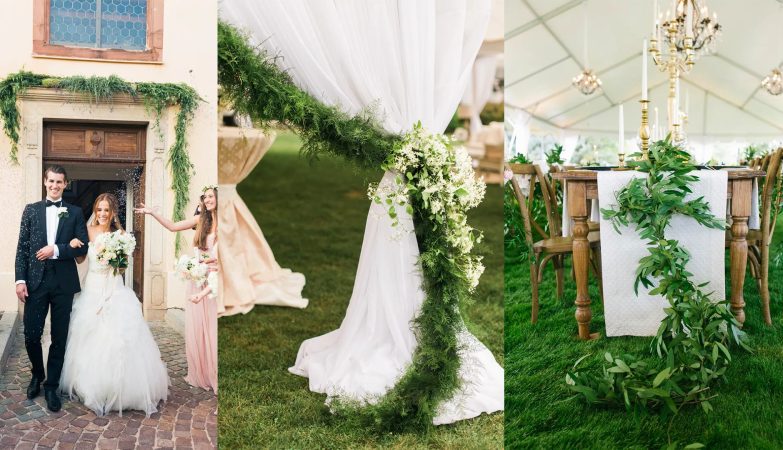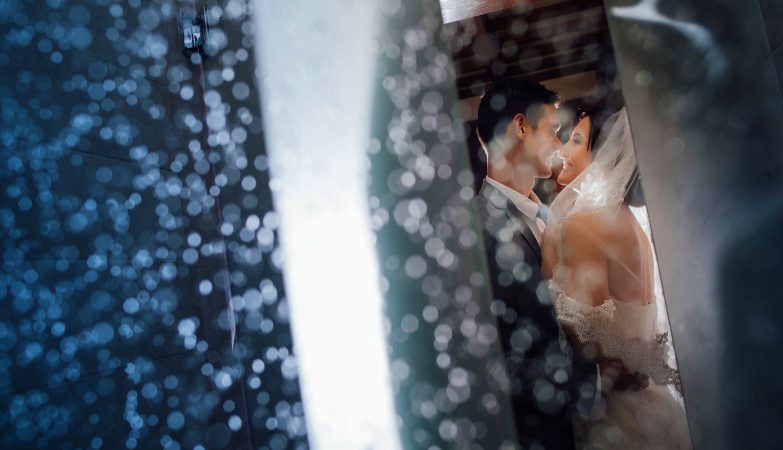
Bridal highlighting and contouring is a makeup technique specifically tailored for brides to enhance their natural features and create a flawless, radiant look on their wedding day. Highlighting refers to the application of a lighter shade of makeup to areas of the face that naturally catch the light, such as the cheekbones and brow bone, to create a soft glow. On the other hand, contouring involves applying a darker shade of makeup to the hollows of the face, such as the temples and jawline, to create definition and add depth. The purpose of this technique is to balance and define the face, ensuring that the bride looks her best both in person and in photographs.
The importance of highlighting and contouring for brides on their wedding day cannot be overstated. These techniques allow for the enhancement of the bride’s natural features, ensuring that she looks radiant and flawless on her special day. By strategically applying makeup to areas that catch the light and those that create shadows, brides can achieve a beautifully balanced and sculpted face. This is particularly crucial for weddings, as the photographs taken on this day will be cherished for a lifetime, and the bride deserves to look her absolute best in them.
Highlighting and contouring can create a stunning effect by bringing out the bride’s best features. Highlighting the high points of the face, such as the cheekbones, brow bone, and cupid’s bow, adds a luminous glow and draws attention to these areas. On the other hand, contouring allows for the sculpting and defining of facial features, such as the nose, jawline, and temples, creating a more chiseled and defined look. Together, these techniques can create a beautifully balanced face, ensuring that the bride looks breathtakingly radiant in person and in photographs on her wedding day.
Understanding the Basics of Highlighting and Contouring
Explanation of highlighting and contouring as makeup techniques that can enhance facial features and create a more defined and sculpted look. Highlighting and contouring are makeup techniques that have gained immense popularity in recent years. Highlighting involves using a light shade to accentuate the high points of the face, like the cheekbones, brow bone, and the cupid’s bow. This technique creates a luminous glow and draws attention to these areas. On the other hand, contouring allows for the sculpting and defining of facial features, such as the nose, jawline, and temples, creating a more chiseled and defined look. These techniques can be tailored to suit an individual’s face shape and can make a significant difference in creating a beautifully balanced face. By strategically applying and blending highlight and contour products, a makeup artist can ensure that the bride looks breathtakingly radiant in person and in photographs on her wedding day. Whether it’s enhancing cheekbones or slimming down the nose, understanding the basics of highlighting and contouring allows for endless possibilities to enhance one’s natural beauty.
Differentiating between highlighting and contouring is crucial for achieving the desired effect. Highlighting involves applying a lighter shade of makeup to areas that you want to bring forward and emphasize, such as the high points of the face like the cheekbones, brow bone, and down the center of the nose. On the other hand, contouring uses a darker shade to create shadows and add depth to areas that you want to appear more sculpted and defined, like the hollows of the cheeks, temples, and jawline. Mastering the art of highlighting and contouring requires practice and understanding of your own unique face shape. For example, let’s say you have a round face shape. To highlight, you would apply a lighter shade of foundation or concealer to your cheekbones, brow bone, and down the center of your nose to create the illusion of more defined features. To contour, you would use a darker shade along the hollows of your cheeks, temples, and jawline to create shadows and make your face appear more sculpted and angular. By mastering this technique, you can transform your face shape and achieve
Understanding the principles of light and shadow in creating dimension on the face. a more symmetrical and balanced appearance. It is important to remember that contouring and highlighting should be done subtly, blending the products well to avoid any harsh lines. With practice, you can enhance your natural features and create a stunning, flawless look. Experimenting with different shades and techniques can help you find the perfect contouring and highlighting routine that suits your face shape and personal style.
Essential Products and Tools Needed
Recommended makeup products for bridal highlighting and contouring include a good-quality foundation or concealer, a contouring powder or cream, a highlighting powder or liquid, a fluffy brush for blending, and a beauty sponge for seamless application. To achieve a seamless and professional-looking result, it is important to choose products that are well-suited to your skin type and tone. A good-quality foundation or concealer that matches your skin perfectly will provide a smooth base for contouring and highlighting. A contouring powder or cream that is a few shades darker than your natural skin tone will help create depth and definition, while a highlighting powder or liquid that is a shade lighter will bring light to the high points of your face. Using a fluffy brush for blending will ensure that there are no harsh lines or visible transitions between the different shades, while a beauty sponge can be used to seamlessly blend the products into the skin for a flawless finish.
Brushes and tools required for flawless application include a foundation brush, eyeshadow brushes, a fluffy blending brush, and a beauty sponge. These tools are essential for precise application and achieving a professional-looking result. The foundation brush allows for even distribution of product, while eyeshadow brushes help create precise and detailed eye looks. The fluffy blending brush ensures seamless blending of eyeshadows and contours, and the beauty sponge is perfect for flawless and airbrushed application of foundation and highlighter. Remember to clean and maintain these brushes regularly to keep them hygienic and long-lasting.
Tips For Selecting the Right Shades and Textures for Different Skin Tones and Types: Skin tones and skin types are also important to consider when choosing makeup products. It’s crucial to find foundation shades that match your skin tone to avoid any visible lines or unevenness. Additionally, understanding your skin type can help determine the best formulas and textures for your complexion. For example, those with oily skin may benefit from oil-free or matte foundations, while those with dry skin may prefer hydrating or dewy formulas. It’s always a good idea to test out products before purchasing them to ensure they work well with your skin.
Step-by-Step Guide to Applying Bridal Highlighting and Contouring
Preparing the skin for makeup application includes cleansing, toning, and moisturizing. These steps help create a smooth canvas for the makeup and ensure that it lasts throughout the day. After prepping the skin, the next step is to apply a primer to further enhance the longevity of the makeup. This step also helps to minimize the appearance of pores and fine lines. Once the primer is applied, it’s time to start the highlighting and contouring process. Highlighting involves using a lighter shade of foundation or concealer to bring forward the high points of the face, such as the cheekbones and brow bone. Contouring, on the other hand, involves using a darker shade of foundation or bronzer to create shadows and define the features, such as the jawline and nose. The key to achieving a natural and seamless look is to blend the highlight and contour products well using a damp beauty sponge or brush. Finally, set the highlighted areas with a translucent powder to prolong the wear of the makeup and prevent any creasing or smudging.
Foundation and concealer techniques for a smooth base include properly matching your skin tone and using the right amount of product for a natural finish. It is important to choose a foundation shade that closely matches your skin tone to avoid any noticeable lines or patches. Applying too much foundation can result in a heavy and cakey appearance, so it is best to start with a small amount and build up if needed. Concealer should be used sparingly to cover any blemishes or dark circles, blending it seamlessly with the foundation for a flawless finish.
Highlighting the high points of the face to enhance natural features can create a luminous and youthful glow. Using a cream or liquid highlighter on the cheekbones, brow bones, and down the bridge of the nose can help achieve this effect. Additionally, a touch of highlighter on the inner corners of the eyes can make them appear brighter and more awake.
Remember to blend the highlighter well to avoid any harsh lines and to maintain a natural-looking finish.
Contouring to Define and Sculpt the Face
Identifying the areas to contour based on face shape will help create a more defined and sculpted look. Some common areas to contour include the hollows of the cheeks, the jawline, and the sides of the nose. By using a cool-toned matte bronzer or contour powder, one can add shadows to these areas, creating the illusion of a more chiseled face shape. It is important to blend the contour well to avoid any harsh lines and to ensure a seamless transition between the highlighted and contoured areas. The overall goal of contouring is to enhance the natural bone structure and create a more defined and sculpted look.
Techniques for creating definition and slimming certain features include using darker shades of contour powder or cream on areas such as the cheekbones, jawline, and nose and blending them outwards towards the hairline and chin. Additionally, contouring can also be used to minimize the appearance of a double chin by applying a darker shade of contour powder or cream underneath the chin and blending it downwards towards the neck. By strategically placing shadows and highlights, one can achieve a more symmetrical and balanced facial appearance. Remember to always use a light hand and build up the intensity gradually to avoid any harsh or unnatural effects. For example, someone could use contouring techniques to sculpt their cheekbones by applying a darker shade of contour powder or cream just underneath the cheekbones and blending upwards towards the temples. This can create the illusion of higher, more defined cheekbones. Additionally, contouring can be used to slim down the appearance of a wider nose by applying a darker shade of contour powder or cream on the sides of the nose and blending it outwards, while highlighting the bridge of the nose with a lighter shade to create the illusion of a more narrow nose shape.
Blending and layering for a seamless and natural look is key to achieving a flawless finish. Blending helps to seamlessly blend the darker and lighter shades together, creating a smooth gradient that mimics natural shadows and highlights on the face. Layering, on the other hand, allows for more control over the intensity of the contour and highlight. By gradually adding and blending layers of product, one can achieve a subtle and natural look or build up the contour for a more dramatic effect. Remember, practice makes perfect when it comes to mastering the art of contouring and achieving that flawless finish.
Additional Tips and Tricks
Avoiding common mistakes when applying bridal highlighting and contouring can help ensure a flawless and beautiful bridal makeup look on your special day. Some common mistakes to avoid when applying bridal highlighting and contouring include using too much product, not blending properly, and not considering the lighting conditions of the venue. It’s important to start with a small amount of product and build it up gradually to avoid looking too heavy or cakey. Additionally, blending is key to achieving a seamless and natural finish. Lastly, consider the lighting conditions of your wedding venue and adjust your highlighting and contouring accordingly to ensure that your features are accentuated in the best way possible on your special day. For example, if a bride applies too much contouring product without proper blending, her face may appear harsh and overly defined in photographs. On the other hand, if she doesn’t adjust her highlighting and contouring to match the lighting conditions of the venue, her features may look washed out or less defined in person or in photographs.
Setting the makeup to ensure long-lasting effects is crucial for maintaining a flawless appearance throughout the event. Setting the makeup can be achieved with the use of a setting powder or spray, which helps to lock in the products and prevent them from smudging or fading. This step is especially important for a special event like a wedding, where the bride will be photographed extensively and needs her makeup to last for hours. By setting the makeup, the bride can confidently enjoy her day without worrying about touch-ups or her makeup melting off.
Advice for touch-ups throughout the wedding day would be to carry a small makeup bag with essential items such as blotting papers, setting spray, lipstick, and powder. These items can easily fit into a clutch or small purse and can be discreetly used throughout the day. Blotting papers are great for removing any excess oil or shine that may appear on the face, while the setting spray can be used to refresh and lock in the makeup. Lipstick and powder are essential for touch-ups, as they can fade or wear off after eating or drinking. By having these items on hand, the bride can ensure that her makeup stays flawless and picture-perfect throughout the entire wedding day. For example, let’s say a bride is having an outdoor summer wedding. The weather is hot and humid, causing her to sweat and her skin to become oily. Throughout the day, she discreetly uses blotting papers to remove any excess oil or shine that appears on her face. She then sprays setting spray to refresh and lock in her makeup, ensuring it stays in place despite the heat. During the reception, she touches up her lipstick and powder after enjoying a meal, preventing any fading or smudging throughout the night.
Conclusion
Overall, touch-ups are essential for maintaining long-lasting makeup, especially in hot and humid weather. Blotting papers are a great tool to remove excess oil and shine, while setting spray helps to refresh and lock in the makeup. Touching up lipstick and powder after meals also prevents any fading or smudging. By incorporating these simple steps, one can ensure their makeup stays flawless throughout the day, even in challenging conditions.
Not only does highlighting and contouring add dimension to the face, but it also helps to accentuate the bride’s best features in photographs. By using a light-reflecting highlighter on the high points of the face and contouring the hollows, brides can achieve a beautifully sculpted look that will last from the ceremony to the reception. Additionally, using long-lasting and waterproof products will ensure that the makeup stays intact, even through tears of joy.
On her special day, the bride deserves to feel confident and beautiful. By choosing makeup products that are designed to withstand challenging conditions, she can ensure that her makeup stays flawless throughout the day. With the help of highlighting and contouring techniques, she can not only enhance her features but also capture stunning photographs that she will cherish forever. Ultimately, it is my heartfelt wish that the bride has a magical and unforgettable wedding day filled with love, joy, and beautiful memories.






